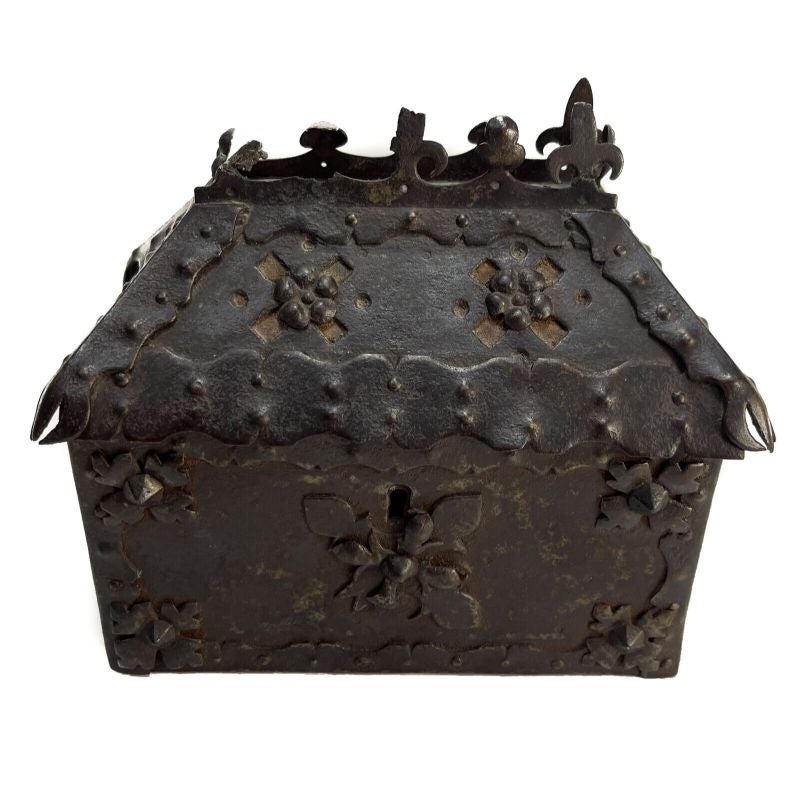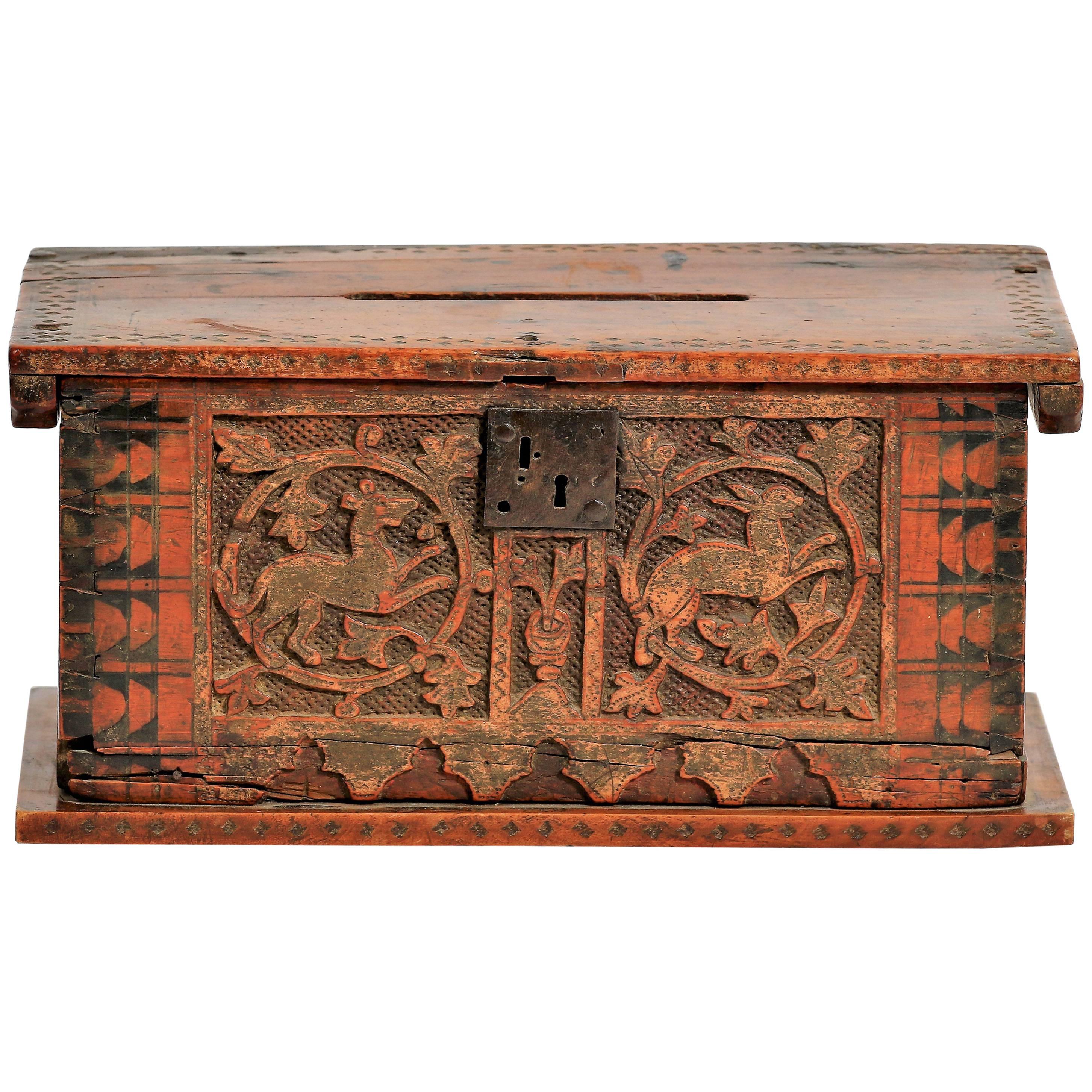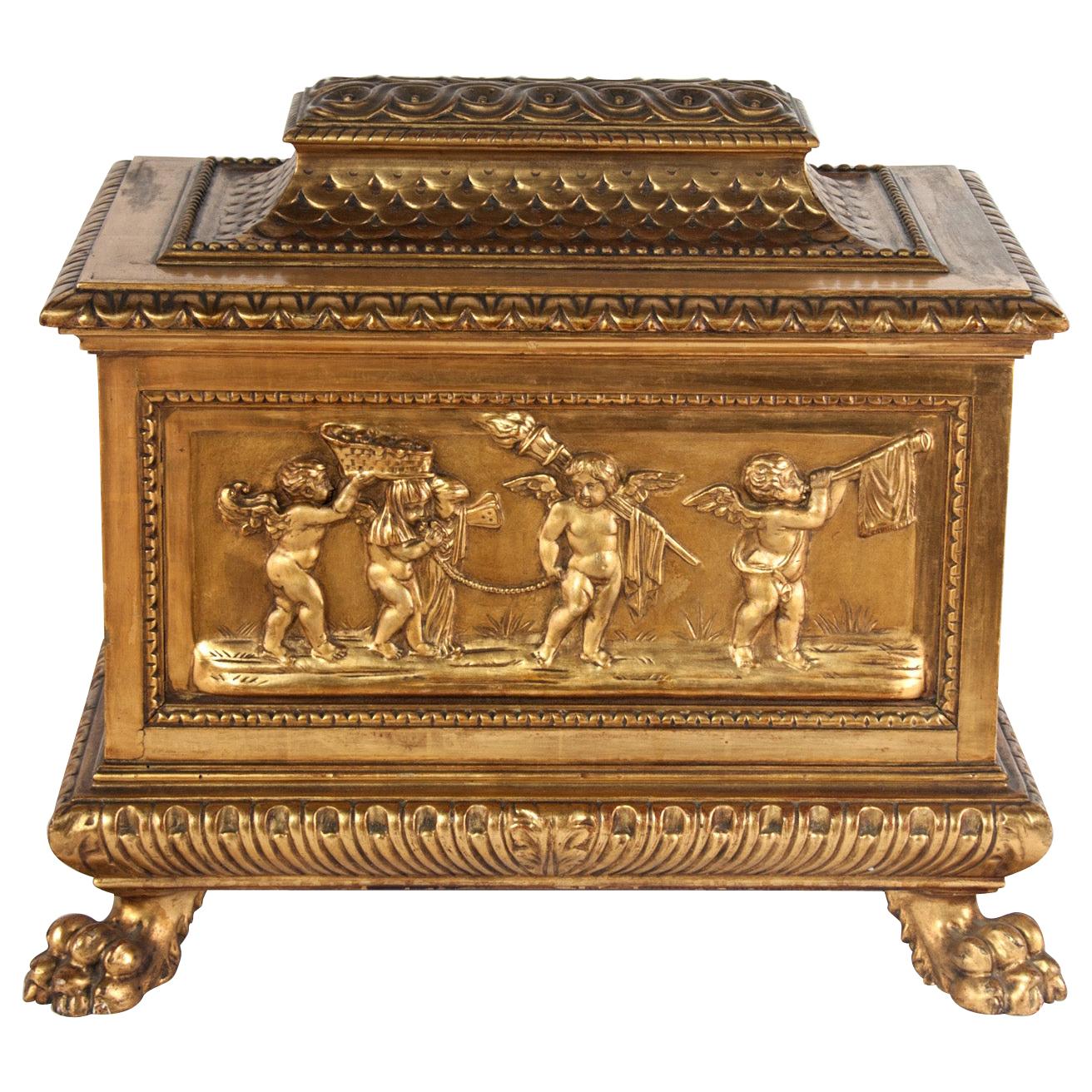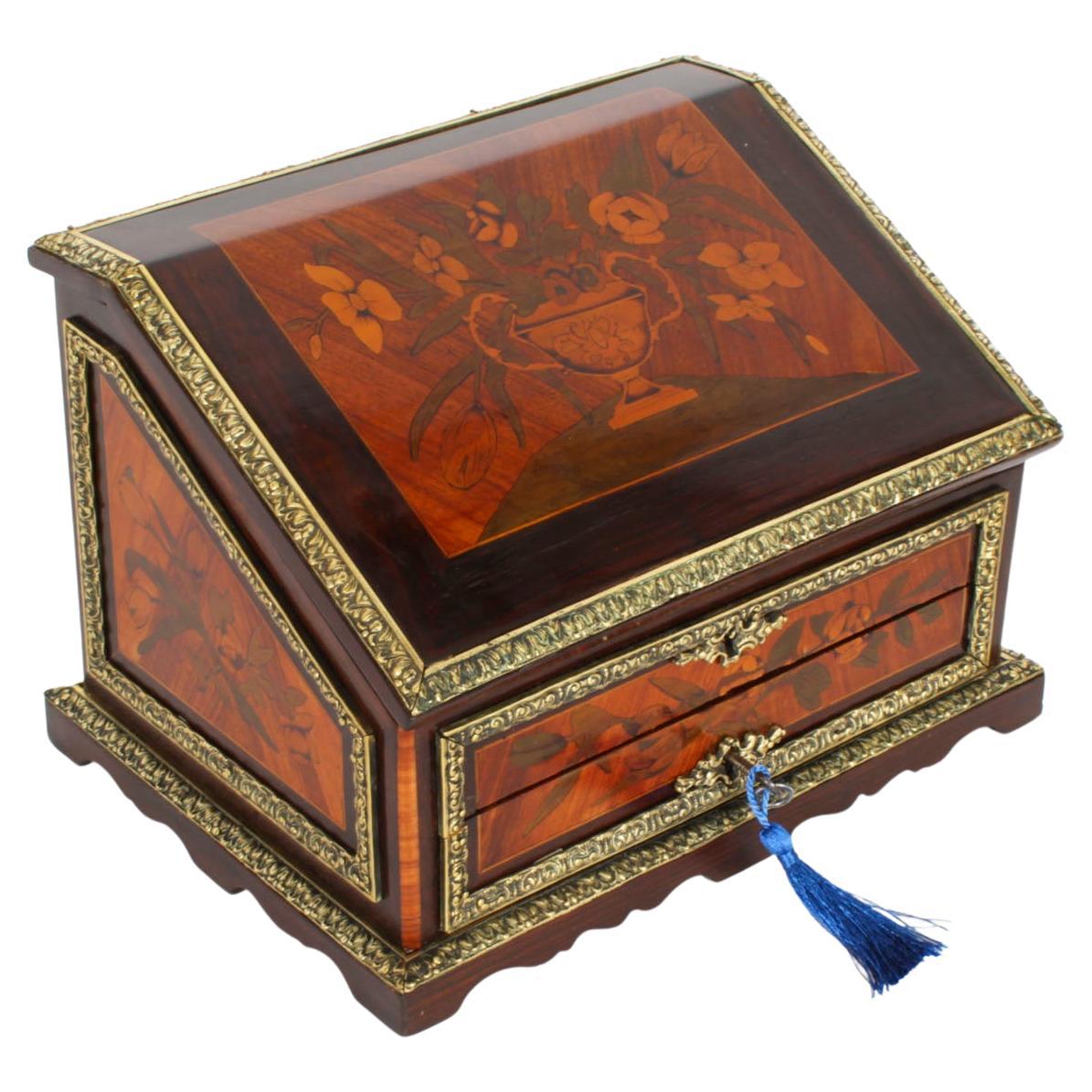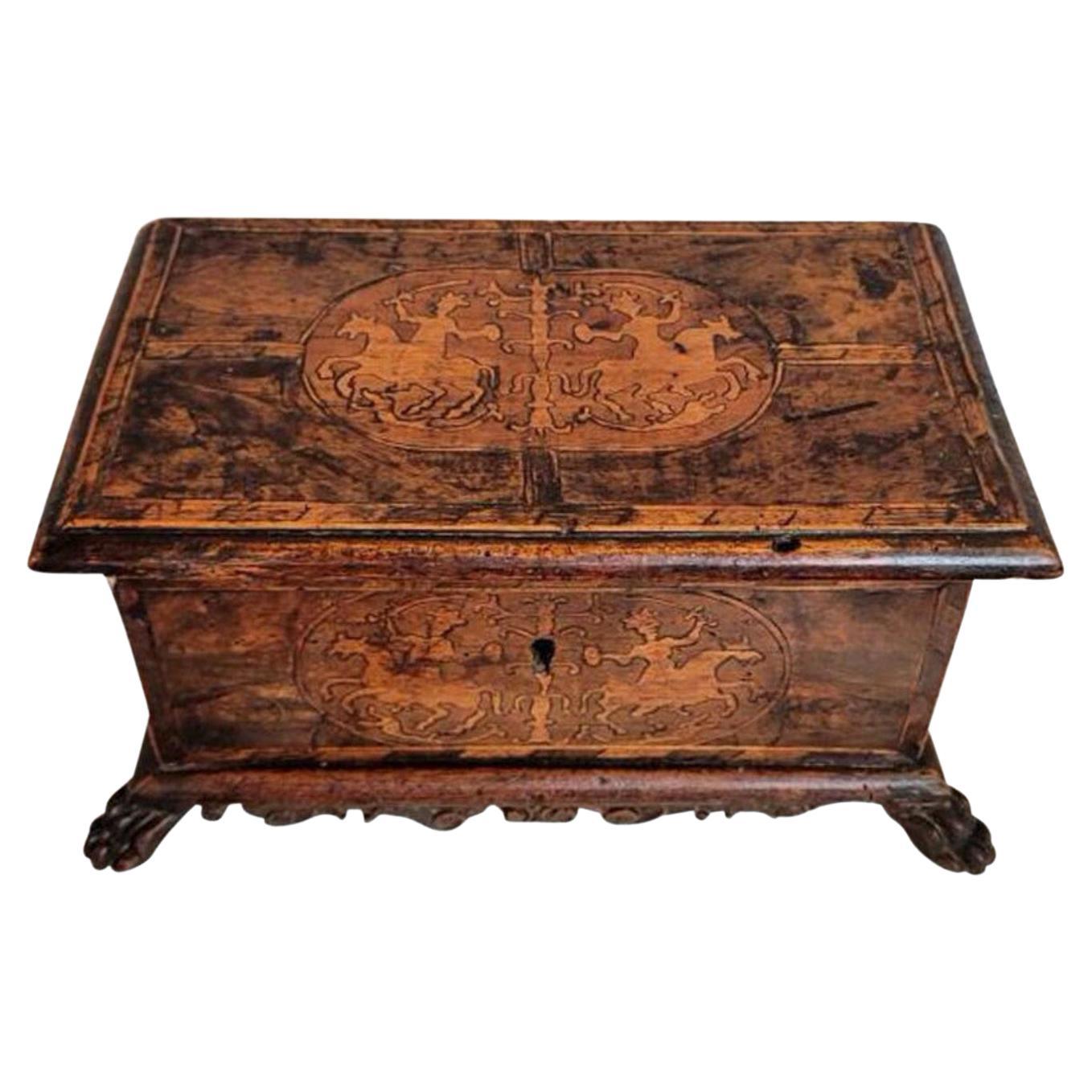Items Similar to Embriachi workshop marquetry casket - Northern Italy, 15th century
Want more images or videos?
Request additional images or videos from the seller
1 of 7
Embriachi workshop marquetry casket - Northern Italy, 15th century
About the Item
Embriachi workshop marquetry casket
Northern Italy, 15th century
Alla certosina inlays (bone, stained bone, pewter and wood)
H 28.2 x W 18 x D 14 cm
This beautiful casket of rectangular form is richly decorated with the characteristic geometric patterns of the Embriachi style.
The intricate geometric patterns are fashioned by juxtaposing lighter and darker pieces of wood, (colored) bone, horn and pewter. The lid and base are framed by a broad band of horn. When ivory became scarce in Europe due to disrupted trade routes, bone was substituted.
The attention to Symmetry and balance created an harmonious visual effect
Enhancing the overall aesthetic appeal of the casket.
The application of geometrical motifs is in Italy known as marquetry ‘alla Certosina’, named after the Certosina Church in Pavia with its famous altarpiece decorated in this way. This is ‘intarsia technique’, a term derived from the Arabic 'tarsi', which means ‘incrustation' recalling ancient mosaics made from various materials.
These geometric elements not only enhance the aesthetic appeal of the caskets but also demonstrate the versatility and skill of the artisans in creating multifaceted works of art.
‘Alla Certosina’ became famous through the Northern Italian Embriachi family who achieved a particularly high standard in working in this technique. Venice in particular was known for the production of these luxurious boxes. The caskets, hexagonal or rectangular, surmounted by a lid decorated in several registers constitute the secular, albeit equally renowned component of the workshop’s production, in addition to mirror frames and various everyday objects.
The method of fabrication of those objects was based on two concepts that underlay pre-industrial production: standardization and modularity, thanks to a distribution of skills according to the different phases of fabrication.
even the realization of the marquetry motifs (in the form of ingots from which portions of the desired size were cut) were therefore entrusted to various specialized craftsmen, as were the assembly phase.
Today better known thanks to the extensive research work recently carried out by Michele Tomasi, this workshop owes its name to its founder and owner, the Florentine Baldassare Ubriachi (or degli Embriachi), a merchant and banker established in the Tuscan capital before he settled in Venice in 1395. Together with sculptor Giovanni di Jacopo, who directed the workshop, from the last years of the fourteenth century, Baldassare oversaw a production that was truly original, and still easily recognizable today, comprising monumental altarpieces and various objects, primarily triptychs and caskets.
The precise location of the workshop is unknown, except that it originated in Florence and in ca. 1431 there was apparently a workshop in Venice, in the area of S Luca. They employed local workers specializing in 'certosina' (inlay of stained woods, bone and horn), and the workshop produced items carved in bone (usually horse or ox) with wood and bone marquetry.
The geometric decoration of Embriachi caskets reflects the artistic complexity and attention to detail that characterized their work.
this inlaid casket is a testament to the skill and artistry of the Embriachi family and serves as a stunning example of the decorative arts of the late Middle Ages.
Related Literature :
E. Berger, Prunk-Kassetten: Europäischen Meisterwerke aus acht Jahrhunderten / Ornamental Caskets: Eight Centuries of European Craftsmanship, Hanns Schell Collection, Stuttgart/Graz 1998, pp. 89-101.
Gaborit-Chopin Danielle. Michele Tomasi, Monumenti d’avorio. I dossali degli Embriachi e i loro commitenti. Monuments d’ivoire. Les devants d’autel des Embriachi et leurs commanditaires. In: Bulletin Monumental, tome 170, n°2, année 2012. pp. 185-186
F. Gualandi, L. Mor & G. Gaggioli, Capsellae. Cassette-reliquario e cofanetti della collezione Fornaro Gaggioli. Secoli XIII-XVI, Bologna 2006, pp. 24-26.
P. Lorenzelli & A. Veca, Tra/e: Teche, pissidi, cofani e forzieri dall’Alto Medioevo al Barocco, Gallereria Lorenzelli, Bergamo 1984, p. 337-344.
M. Pall, Versperrbare Kostbarkeiten, Kästchen und Kabinette aus der Welt, Hanns Schell Collection, Graz 2006, p. 38.
- Dimensions:Height: 11.11 in (28.2 cm)Width: 7.09 in (18 cm)Depth: 5.91 in (15 cm)
- Style:Renaissance (Of the Period)
- Materials and Techniques:
- Place of Origin:
- Period:
- Date of Manufacture:15th century
- Condition:Additions or alterations made to the original: the lock is missing20000. Wear consistent with age and use.
- Seller Location:Bruxelles, BE
- Reference Number:1stDibs: LU6666238331932
About the Seller
5.0
Vetted Seller
These experienced sellers undergo a comprehensive evaluation by our team of in-house experts.
1stDibs seller since 2022
6 sales on 1stDibs
Typical response time: 4 hours
- ShippingRetrieving quote...Ships From: Bruxelles, Belgium
- Return PolicyA return for this item may be initiated within 3 days of delivery.
More From This SellerView All
- Ecce Homo - Florence, 15th centuryLocated in Bruxelles, BEA terracotta bust "Ecce Homo" Florence, 15th century 53 x 44 x 31 cmCategory
Antique 15th Century and Earlier Italian Renaissance Figurative Sculptures
MaterialsTerracotta
- Gothic Canopy, France, 15th CenturyLocated in Bruxelles, BEGothic canopy France, 15th century Alabaster, some traces of polychromy 33 x 23 x 20 cm Provenance: - Private collection Genève, Switzerland ...Category
Antique 15th Century and Earlier French Gothic Figurative Sculptures
MaterialsAlabaster
- Rare pastiglia marriage chest - North of Italy, First half of 15th centuryLocated in Bruxelles, BERare pastiglia marriage chest North of Italy, Liguria or Piemonte First half of 15th century wood, gesso, partly gilded, form molded and painted 67 x 156 x 63 cm Provenance : Pri...Category
Antique 15th Century and Earlier Italian Renaissance Blanket Chests
MaterialsGesso, Wood
- Terracotta Bust of Christ as the Redeemer, 15th CenturyLocated in Bruxelles, BEA terracotta bust of Christ as The Redeemer Tuscany or Emilia Romagna, late 15th century Measures: 46 x 43 x 21 cm This powerful, moving bust of...Category
Antique 15th Century and Earlier Italian Renaissance Figurative Sculptures
MaterialsTerracotta
- Turned, Engraved Openwork Box, Florence, 17th CenturyLocated in Bruxelles, BETurned, engraved and openwork box Fruit wood Florence, 17th century Measures: Diameter 11cm Height 4.4cm.Category
Antique 17th Century Italian Renaissance Decorative Boxes
MaterialsWood
- Attributed to Domenico di Paris - Madonna and The Child, 15th centuryLocated in Bruxelles, BEAttributed to Domenico di Paris, also called Domenico del Cavallo ( Monselice, documented in Ferrara between 1442 and 1501) Madonna and The Child Polychromed and gilded Stucco 47,5 ...Category
Antique 15th Century and Earlier Italian Renaissance Wall-mounted Sculpt...
MaterialsStucco
You May Also Like
- Medieval Patinated Iron-Mounted Oak Casket, 15th CenturyLocated in Gardena, CAMedieval patinated iron-mounted oak casket, 15th century A Continental Medieval patinated iron mounted oak wood box. 15th Century or earlier. Addition...Category
Antique 15th Century and Earlier Medieval Decorative Boxes
MaterialsIron
- Very Rare Casket Minnekästchen or Box, Germany or Italy, 15th CenturyLocated in Beuzevillette, FRWooden coffret, call minnekästchen, engraved with a dog, a hare and foliage with polychromy remains. During the Middle Age, the hare is a symbol of fertility, joy and represents the Christ...Category
Antique 15th Century and Earlier European Gothic Decorative Boxes
MaterialsIron
- A 19th Century Marquetry Italian Letter CasketLocated in Lincolnshire, GBA fine quality marquetry inlaid walnut and olive wood Italian letter or paper box, the shaped top lid with a pastoral scene and shepherdess. Circa 1870Category
Antique 19th Century Italian Decorative Boxes
MaterialsOlive, Walnut
- Italian 19th C. polychromed Wooden Casket.Located in Esbeek, NLItalian Renaissance casket. The casket with raised lid all carved with Cherubs on the front and back panel. Original polychromeCategory
Antique 19th Century Italian Renaissance Decorative Boxes
MaterialsWood
- Antique French Marquetry and Ormolu Stationary Casket . 19th CenturyLocated in London, GBThis is a wonderful antique French Gonçalo Alves marquetry and ormolu mounted casket, circa 1860 in date. The casket of bureau form has a lift up top and is inlaid with a marquetry ...Category
Antique 1860s Decorative Boxes
MaterialsOrmolu
- 17th/18th Century Italian Venetian Marquetry Table BoxLocated in Forney, TXAn important early antique Italian Renaissance table box, handcrafted in Northern Italy in the 17th/18th century, cassone chest form, richly inlaid, the top and front panel with fruitwood banding framing...Category
Antique 18th Century Italian Renaissance Decorative Boxes
MaterialsWood, Fruitwood
Recently Viewed
View AllMore Ways To Browse
Box Ivoire
Bone Casket
Prismatic Lucite Box
Asprey Cigarette Box
Carl Valente
Vintage Onyx And Agate Lidded Vessel Box
China Trinket Box
Victorian Document Box
Morocco Perfume Bottle
Box Ivoire
Satin Wood Box
Burl Walnut Box
Stag Box
Huntley And Palmers Tin
Ralph Lauren Silver Box
Red Lacquer Wedding Box
Silver Box Ralph Lauren
Tessellated Horn Box
